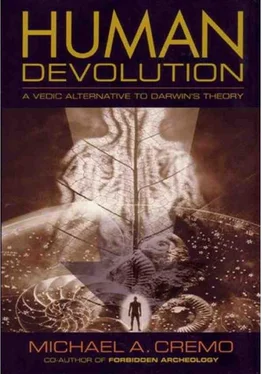Michael Cremo - Human Devolution - A Vedic Alternative To Darwin's Theory
Здесь есть возможность читать онлайн «Michael Cremo - Human Devolution - A Vedic Alternative To Darwin's Theory» весь текст электронной книги совершенно бесплатно (целиком полную версию без сокращений). В некоторых случаях можно слушать аудио, скачать через торрент в формате fb2 и присутствует краткое содержание. Год выпуска: 2003, ISBN: 2003, Издательство: Torchlight Publishing, Жанр: Старинная литература, на английском языке. Описание произведения, (предисловие) а так же отзывы посетителей доступны на портале библиотеки ЛибКат.
- Название:Human Devolution: A Vedic Alternative To Darwin's Theory
- Автор:
- Издательство:Torchlight Publishing
- Жанр:
- Год:2003
- ISBN:9780892133345
- Рейтинг книги:4 / 5. Голосов: 1
-
Избранное:Добавить в избранное
- Отзывы:
-
Ваша оценка:
- 80
- 1
- 2
- 3
- 4
- 5
Human Devolution: A Vedic Alternative To Darwin's Theory: краткое содержание, описание и аннотация
Предлагаем к чтению аннотацию, описание, краткое содержание или предисловие (зависит от того, что написал сам автор книги «Human Devolution: A Vedic Alternative To Darwin's Theory»). Если вы не нашли необходимую информацию о книге — напишите в комментариях, мы постараемся отыскать её.
Human Devolution: A Vedic Alternative To Darwin's Theory — читать онлайн бесплатно полную книгу (весь текст) целиком
Ниже представлен текст книги, разбитый по страницам. Система сохранения места последней прочитанной страницы, позволяет с удобством читать онлайн бесплатно книгу «Human Devolution: A Vedic Alternative To Darwin's Theory», без необходимости каждый раз заново искать на чём Вы остановились. Поставьте закладку, и сможете в любой момент перейти на страницу, на которой закончили чтение.
Интервал:
Закладка:
As Lord Krishna says in the Bhagavad Gita (15.7), “The living entities in this conditioned world are My eternal fragmental parts. Due to conditioned life, they are struggling very hard with the six senses, which include the mind.” God is an eternally conscious person, and the living entities are also eternally conscious persons. In their original state, the deathless living entities exercise their free will to act in connection with God, in the pleasure-filled realm of pure spiritual energy. Some of the living entities, however, misuse their free will to act independently of God. Attracted by the material energy, they become covered by bodies composed of mind and matter. In this state, their natural freedom is constrained by the conditions imposed upon them by their bodies, with which they struggle to enjoy the material energy, in a cycle of repeated births and deaths. It is possible, however, for such living entities to regain their deathless and blissful spiritual state.
Forbidden Archeology:
The Hidden History of the Human Race
Upon hearing the proposal that human beings are devolved spirits rather than the modified descendants of extinct apelike creatures, one might ask: Has not science, using physical evidence, demonstrated beyond doubt that we did in fact evolve, by natural selection, from more anatomically primitive hominids? There is certainly a lot of talk and writing to that effect. But in the 932 pages of Forbidden Archeology, Richard Thompson and I documented abundant physical evidence contradicting the current evolutionary theory of human origins. Forbidden Archeology (also available in abridged form as The Hidden History of the Human Race ) is thus the indispensable prelude to Human Devolution. In this chapter, I will summarize the essential points made in Forbidden Archeology. But there is no substitute for reading the entire book and seeing for oneself the massive amounts of evidence that contradict the idea that anatomically modern humans evolved within the past 6 million years from very apelike hominid ancestors. This evidence confirms that we really do require an alternative to the present theory.
William W. Howells, emeritus professor of physical anthropology at Harvard University, and one of the chief architects of the modern theory of human evolution, wrote to me on August 10, 1993: “Thank you for sending me a copy of Forbidden Archeology , which represents much careful effort in critically assembling published materials. I have given it a good examination. . . . Most of us, mistakenly or not, see human evolution as a succession of branchings from earlier to more advanced forms of primate, with man emerging rather late. . . . To have modern human beings . . . appearing a great deal earlier, in fact at a time when even simple primates did not exist as possible ancestors, would be devastating not only to the accepted pattern. It would be devastating to the whole theory of evolution.” Yes, and it would demand an alternative hypothesis. Howells went on to say, “The suggested hypothesis would demand a kind of process which could not possibly be accommodated by evolutionary theory as we know it, and I should think it requires an explanation.” Human Devolution provides the explanation Howells requested, the explanation of a process that lies outside the range of current evolutionary theory. But first, we should understand exactly why such a new hypothesis is in fact required.
Problems with Current Theory
Mainstream physical anthropologists agree among themselves that hominids, the biological group that includes today’s humans and their supposed ancestors, split off from the African apes around 6 million years ago. There is, however, little agreement about the identity of the very first hominids. In the last decade of the twentieth century and the early years of the twenty-first century, physical anthropologists and archeologists uncovered fragmentary remains of a variety of new hominid species. From some of these early hominids came Australopithecus. There are, we are told, many species of Australopithecus . The earliest of these came into existence about 4 or 5 million years ago. From one of them arose Homo habilis , the first toolmaker. Next came Homo erectus , the first hominid to use fire. Then came early modern humans and the Neandertals. Finally, anatomically modern humans arrived on the scene about 100,000 years ago. It all sounds so perfectly clear when you hear a teacher say it, when you read it in a book, or when you see it in a museum display or on television. But behind the scenes, there are major ongoing disputes about each stage of this progression.
When scientists say that humans came from apes, they do not mean the modern apes we see in zoos, such as gorillas and chimpanzees. They mean the extinct dryopithecine apes of Africa. These apes, supposedly the common ancestors of both modern apes and modern humans, lived in the Miocene period, from about 5 to 20 million years ago. The human line (the hominids) and the modern ape line supposedly split off from their common dryopithecine ancestor about 6–7 million years ago. There are many species of Dryopithecus, however, and scientists cannot yet say exactly which of these extinct apes is our primeval ancestor. Nor can they tell us much about the very first hominids, the ones that existed before Australopithecus. Their fossil remains, mostly discovered after the publication of Forbidden Archeology in 1993 , are fragmentary and subject to multiple interpretations.
Lemonick and Dorfman (2001) give a good review of the current confused state of early hominid paleontology. In 1994, researchers uncovered bones that they attributed to a creature called Ardipithecus ramidus, who lived in Ethiopia 4.4 million years ago. In 2001, researchers from America and Ethiopia announced the discovery of more Ardipithecus bones, this time 5.8 million years old. Ardipithecus had roughly the same size and body structure as a chimpanzee, with an important exception. The researchers found a toe bone with a humanlike structure, indicating Ardipithecus walked upright. But Donald Johanson, director of the Institute for Human Origins at the University of Arizona, pointed out that the toe bone was found ten miles from the other bones and was several hundred thousand years older. It was therefore not clear that the highly significant toe bone belonged to Ardipithecus. Perhaps it belonged to actual humans present millions of years ago in Africa? That is not impossible, because there is plenty of evidence that anatomically modern humans did exist millions of years ago in Africa and elsewhere. In any case, the Ardipithecus researchers proposed that the line of human origins went through the older Ardipithecus at 5.8 million years to the younger Ardipithecus at 4.4 million years to Australopithecus afarensis (Lucy) at 3.2 million years and then on to the first members of the genus Homo at around 2 million years ago.
In the year 2000 a team of French and Kenyan researchers led by Brigitte Senut and Martin Pickford uncovered some bones of a creature they called orrorin tugenensis, popularly known as Millenium Man. Senut and Pickford said that Ardipithecus is simply an ape, with no direct place in the human lineage. They also denied that Australopithecus afarensis was a human ancestor. The bones of Millenium Man were 6 million years old. Senut and Pickford believed the bones showed that Millenium Man walked upright on two legs, a key human trait, but other researchers such as Meave Leakey remained unconvinced. Furthermore, Bernard Wood (Culotta 1999), of the George Washington University, questioned the whole idea that early primates with skeletal remains indicating bipedalism should automatically be considered human ancestors. Maybe they were just apes that happened to walk on two legs and had no connection with humans.
Читать дальшеИнтервал:
Закладка:
Похожие книги на «Human Devolution: A Vedic Alternative To Darwin's Theory»
Представляем Вашему вниманию похожие книги на «Human Devolution: A Vedic Alternative To Darwin's Theory» списком для выбора. Мы отобрали схожую по названию и смыслу литературу в надежде предоставить читателям больше вариантов отыскать новые, интересные, ещё непрочитанные произведения.
Обсуждение, отзывы о книге «Human Devolution: A Vedic Alternative To Darwin's Theory» и просто собственные мнения читателей. Оставьте ваши комментарии, напишите, что Вы думаете о произведении, его смысле или главных героях. Укажите что конкретно понравилось, а что нет, и почему Вы так считаете.












